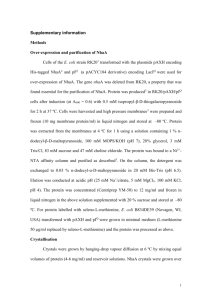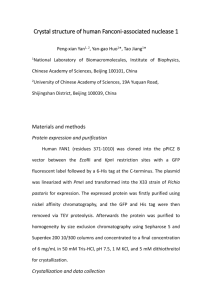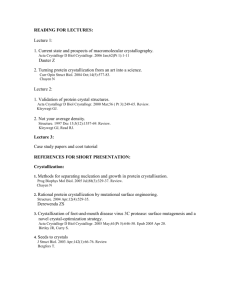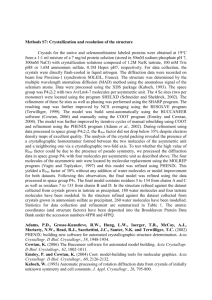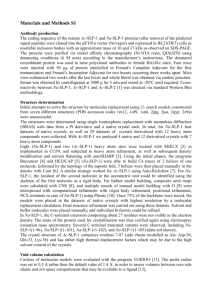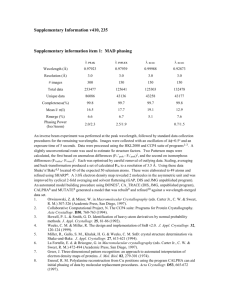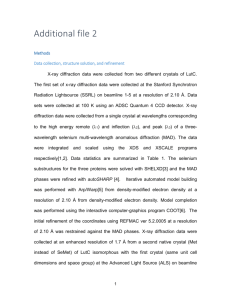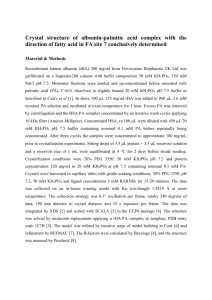pptx
advertisement
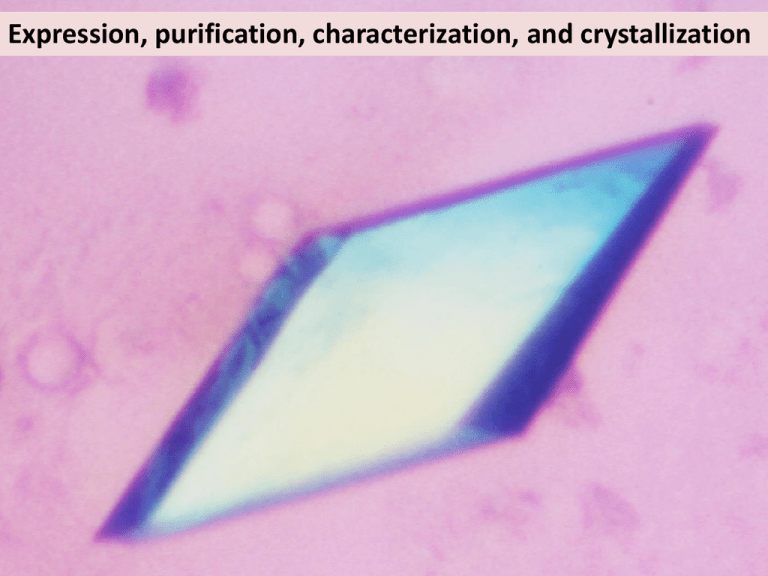
Expression, purification, characterization, and crystallization So how does one go about solving a crystal structure? formulate question make sample make crystal collect diffraction data solve phase problem build model refine model interpret model very hard! cloning, expression, purification screening, optimisation synchrotron, integration, scaling MR, SIRAS, MIRAS, SAD, MAD, hybrid manual or autotracing agreement of model and data very hard! back to top? Boss you you Post-doc Post-doc/Randy/Phil Post-doc/you Post-doc/Garib Boss … and might fail at any step! This is the part where YOU make all the difference!! Disclaimer: This is a limited (i.e. my) view of how to do crystallography You have to find out what works for you (But some of this might be useful) What to crystallize: Different species Bacterial: Archeal: Eukaryotic: Great diversity, Easy to work with Half way between bacterial and eukaryotic more difficult, but sometimes essential What to crystallize: Different species What to crystallize: Different constructs Max Planck Institute Teubingen toolkit => sequence searches, 2ndary structure prediction Clustal (alignments) Jalview (view/edit) What to crystallize: Different constructs Modeller (Andrej Sali, UCSF) What to crystallize: make mutants Surface engineering: hydrophylic residues at loops into hydrophobic residues Mutate active site residues: catch it in the act Derewenda ZS. Application of protein engineering to enhance crystallizability and improve crystal properties. Acta Crystallogr D Biol Crystallogr. 2010 May;66(Pt 5):604-15. PubMed PMID: 20445236 What to crystallize: add partner protein and/or substrate! (or anything else that will stabilize your protein) Partner protein (if complex) Peptide DNA/RNA ATP/GTP (or non-hydrolysable analogue) Inhibitor … But how do you know what to add?? ATPase activity Study your protein! 100 80 60 40 20 0 prep1 prep2 prep3 prep4 SeMet1 SeMet2 … or cross your fingers and hope for the best X family Pol GCCGCGGGAAA (Pelletier ’94) CGGCGCCC Pol (Batra ’06) A family Bacillus (Kiefer ’98) CGACTACGCGACAGCC GCTGATGCGC GTCGG CGTACTACGAGAGA GCATGATGC T7 phage GCTTTTGCTGCCGG TCACGGTTCCCC (Doublie ’98) CGAAAACGACGGCCAGTGCCAAG Taq (Li ’98) CTGGTGCCGCGGGAAA GACCACGGCGCCC B family RB69 GCGCCTGACGAATGGACA (Franklin ’01) GCGGACTGCTTACCdT Y family Dpo4 (Ling ’01) CCCCCTTCCTGATTACTT GGGGGAAGGACTAA A = added during crystallization A = not visible in structure What to crystallize: DO NOT… ..do limited proteolysis .. believe everything that is published Biochemistry (1996) Crystal Structure (2006) Active site: 401/403 β-bind: 920-924 τ-bind: 1072-1160 What to crystallize: how to clone http://www2.lmb.internal/wiki/index.php/Lamers_lab -> cloning Aslanidis C, de Jong PJ. Ligation-independent cloning of PCR products (LIC-PCR). Nucleic Acids Res. 1990 Oct 25;18(20):6069-74. PubMed PMID: 2235490 Protein expression in E. coli What happens here? OD600 Time Studier, F. W. Protein production by auto-induction in high density shaking cultures. Protein Expr Purif 41, 207–234 (2005). E. coli is easily satisfied… Need enough food: 2xTY (or even better: terrific broth) Need Mg: 1mM MgSO4 Need lots of O2:use baffled flasks (Thomson UtraYield) Prevent leaky expression: 1% glucose (and pLysS plasmid) Don’t like extra baggage (i.e your plasmids): do NOT do starter culture Max protein production in 1-2 hrs… Fool proof protocol: Transform enough cell to plate out on 6 plates & grow overnight Scrape ALL cells and inoculate 6 x 0.5 Ltr 2xTY + 1mM MgSO4, 1% Glucose, Antibiotic Grow 2-3 hrs at 37oC to OD600=3-6 in BAFFLED UltraYield flasks (2.5 Ltr) Add 1 volume of RT 2xTY (+Mg, Gluc, Antib, IPTG) Express protein for 1-2 hrs @ 30oC Harvest cells and freeze => 70-100g cells => 80-100mg protein (need ~10 mg to set up 2000 drops) Sorry: I don’t know much about protein expression in yeast, baculovirus or other systems Don’t ever say (or even think): “but this is how everyone does it” Andrew Carter: Yeast to OD600=80 Imre Berger: multi protein expression in baculovirus Wayne Hendrickson: SeMet expression for phasing William Studier: using T7 phages for protein expression in E. coli Protein purification Tags Hydrophobic Ion-exchange Affinity Size exclusion Buffer exchange Protein storage www.gelifesciences.com > Service & support > Handbooks Lysate Phenyl SP Q S200 Protein purification Tags Hydrophobic Ion-exchange Affinity Size exclusion Buffer exchange Protein storage GST is a dimer! N-terminus may be buried or part of active site! Histrap columns can leak Ni into your protein Ni Ni Ni Ni Ni Ni Ni N Protein purification Tags Hydrophobic Ion-exchange Affinity Size exclusion Buffer exchange Protein storage Do you really need to a run a gel filtration run?? Only good if: - You have lots of aggregates - You have degradation products Concentrating afterwards can do more harm then good Protein purification Tags Hydrophobic Ion-exchange Affinity Size exclusion Buffer exchange Protein storage Instead of dialyzing try: * 5-10 fold dilution * Desalting column (30 minutes) * Changing pH by adding HCl or NaOH (within buffer capacity) Protein purification Tags Hydrophobic Ion-exchange Affinity Size exclusion Buffer exchange Protein storage If you can, freeze your protein Flash freeze protein in LN2. Use PCR tubes if needed Thaw in hand, then store on ice Find optimal storage buffer (use solubility screen) Deng, J. et al. An improved protocol for rapid freezing of protein samples for long-term storage. Acta Crystallogr. D Biol. Crystallogr. 60, 203–204 (2004). Protein characterization Solubility Screen 1-10mg/ml 100nl/drop Incubate 1-24 hrs Protein characterization 1-10mg/ml 100nl/drop Incubate 1-24 hrs Solubility Screen See: http://www2.lmb.internal/wiki/index.php/Lamers_lab > Crystallography > Solubility screen Or Jena Bioscience JBScreen Solubility HTS Protein characterization Solubility Screen 1-10mg/ml 100nl/drop Incubate 1-24 hrs Protein characterization Dynamic Light Scattering 5uL, 1-5mg/ml Monodisperse proteins give more crystal hits Jancarik, J., Pufan, R., Hong, C., Kim, S.-H. & Kim, R. Optimum solubility (OS) screening: an efficient method to optimize buffer conditions for homogeneity and crystallization of proteins. Acta Cryst (2004). D60, 1670-1673 (2004) Protein characterization Analytical gel filtration SEC-MALS SEC-SAXS Pol III Clamp 150 10 μM 5 μM 1.5 μM mAU 100 20000 Pol III Clamp 50 0 1.0 10000 0 1.2 1.4 Retention (ml) 1.6 1.8 5 10 15 Fraction 20 Activity assay (Semet MutS) Fluorescence intensity Protein characterization No protein Pol III-clamp-exo Pol III-exo Pol III-clamp-exomuta 250000 200000 150000 Pol III Pol III-clamp 100000 0 500 1000 ATPase activity Time (Sec) 100 80 60 40 20 0 prep1 prep2 prep3 prep4 SeMet1 SeMet2 1500 Protein crystallization Are robotic approaches the best way? Diller DJ, Hol WG. An accurate numerical model for calculating the equilibration rate of a hanging-drop experiment. Acta Crystallogr D Biol Crystallogr. 1999 Mar;55(Pt 3):656-63. PubMed PMID: 10089462. Cryocrystallography (freezing) Principles of cryocrystallography (1) Freeze in liquid nitrogen or gas stream? Beware of the layer of cold air over the liquid nitrogen (2) Test crystal at room temp: Mitegen crystal sleeve: MicroRT Test different cryos & precipitant concentrations Remove any mother liqour (3) Dehydrate with PEGs Dehydrate with controlled humidified air (4) 1. Garman, E. F. & Schneider, T. R. Macromolecular Cryocrystallography. J. Appl. Cryst (1997). 30, 211-237 2. Warkentin, M., Berejnov, V., Husseini, N. S. & Thorne, R. E. Hyperquenching for protein cryocrystallography. J Appl Crystallogr 39, 805–811 (2006). 3. Pellegrini, E., Piano, D. & Bowler, M. W. Direct cryocooling of naked crystals: are cryoprotection agents always necessary? Acta Cryst (2011). D67, 902-906 4. Russi, S. et al. Inducing phase changes in crystals of macromolecules: status and perspectives for controlled crystal dehydration. J. Struct. Biol. 175, 236–243 (2011). First DNA structure, 1953 (Watson & Crick) First protein structure: Haemoblobin 1959 (Perutz & Kendrew) In a difficult project you’re not going to succeed because you do the same as everyone else, but because you do something different… Recommended reading: Ligation Independent Cloning Aslanidis C, de Jong PJ. Ligation-independent cloning of PCR products (LIC-PCR). Nucleic Acids Res. 1990 Oct 25;18(20):6069-74. PubMed PMID: 2235490 Protein expression Studier, F. W. Protein production by auto-induction in high density shaking cultures. Protein Expr Purif 41, 207–234 (2005). Protein enginering Derewenda ZS. Application of protein engineering to enhance crystallizability and improve crystal properties. Acta Crystallogr D Biol Crystallogr. 2010 May;66(Pt 5):604-15. PubMed PMID: 20445236 SERP server http://services.mbi.ucla.edu/SER/ Protein purification www.gelifesciences.com > Service & support > Handbooks Hanging drop diffusion Diller DJ, Hol WG. An accurate numerical model for calculating the equilibration rate of a hanging-drop experiment. Acta Crystallogr D Biol Crystallogr. 1999 Mar;55(Pt 3):656-63. PubMed PMID: 10089462 Cryo crystallography Garman, E. F. & Schneider, T. R. Macromolecular Cryocrystallography. J. Appl. Cryst (1997). 30, 211-237 Warkentin, M., Berejnov, V., Husseini, N. S. & Thorne, R. E. Hyperquenching for protein cryocrystallography. J Appl Crystallogr 39, 805–811 (2006) Pellegrini, E., Piano, D. & Bowler, M. W. Direct cryocooling of naked crystals: are cryoprotection agents always necessary? Acta Cryst (2011). D67, 902-906 Russi, S et al. Inducing phase changes in crystals of macromolecules: status and perspectives for controlled crystal dehydration. J. Struct. Biol. 175, 236-243 (2011) When all goes well…
